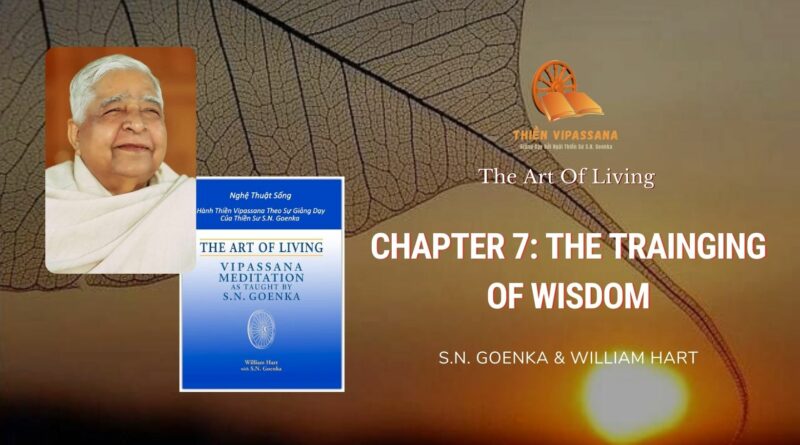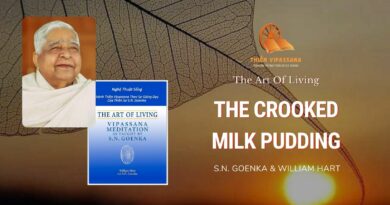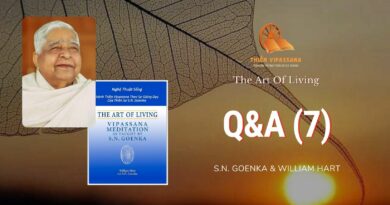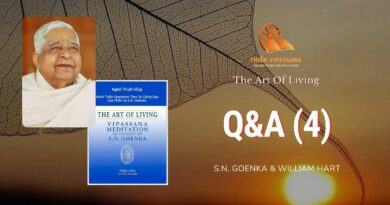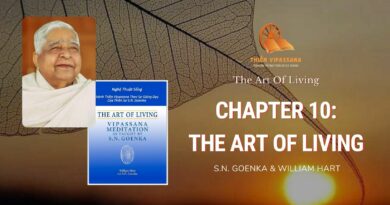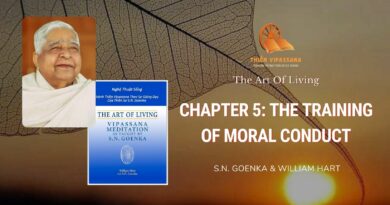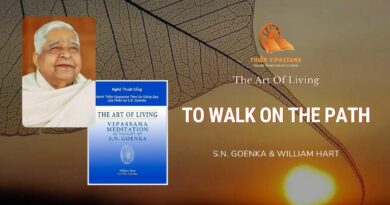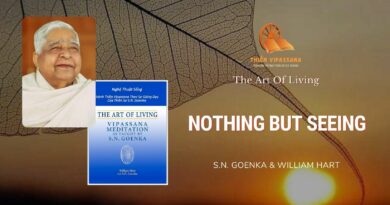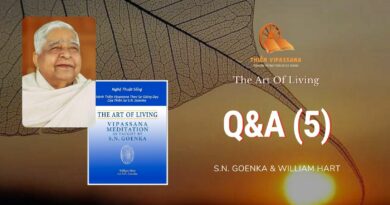Chapter 7. THE TRAINING OF WISDOM
Neither sīla nor samādhi is unique to the teaching of the Buddha. Both were well known and practised before his enlightenment; in fact, while searching for the way to liberation, the future Buddha was trained in samādhi by two teachers with whom he studied. In prescribing these trainings the Buddha did not differ from the teachers of conventional religion. All religions insist on the necessity of moral behavior, and they also offer the possibility of attaining states of bliss, whether by prayer, by rituals, by fasting and other austerities, or by various forms of meditation. The goal of such practices is simply a state of deep mental absorption. This is the “ecstasy” experienced by religious mystics.
Such concentration, even if not developed to the level of the trance states, is very helpful. It calms the mind by diverting attention from the situations in which one would otherwise react with craving and aversion. Counting slowly to ten to prevent an outburst of anger is a rudimentary form of samādhi. Other, perhaps more obvious, forms are repetition of a word or mantra, or concentration on a visual object. They all work: when the attention is diverted to a different object, the mind appears to become calm and peaceful.
The calm achieved in this way, however, is not real liberation. Certainly the practice of concentration confers great benefits, but it works only at the conscious level of the mind. Nearly twenty-five centuries before the invention of modern psychology, the Buddha realized the existence of the unconscious mind, which he called the anusaya. Diverting the attention, he found, is a way to deal effectively with craving and aversion at the conscious level, but it does not actually eliminate them. Instead it pushes them deep into the unconscious, where they remain as dangerous as ever even though dormant. At the surface level of the mind there may be a layer of peace and harmony, but in the depths is a sleeping volcano of suppressed negativity which sooner or later will erupt violently. The Buddha said,
If the roots remain untouched and firm in the ground, a felled tree still puts forth new shoots.
If the underlying habit of craving and aversion is not uprooted, suffering arises anew over and over again.1
So long as conditioning remains in the unconscious mind, it will put forth fresh shoots at the first opportunity, causing suffering. For this reason even after reaching the highest states attainable by the practice of concentration, the future Buddha was not satisfied that he had achieved liberation. He decided that he must continue his search for the way out of suffering and the path to happiness.
He saw two choices. The first is the path of self-indulgence, of giving oneself free license to seek the satisfaction of all one’s desires. This is the worldly path which most people follow, whether they realize it or not. But he saw clearly that it cannot lead to happiness. There is no one in the universe whose desires are always fulfilled, in whose life everything that is wished for happens and nothing happens that is not wished. People who follow this path inevitably suffer when they fail to achieve their desires; that is, they suffer disappointment and dissatisfaction. But they suffer equally when they attain their desires: they suffer from the fear that the desired object will vanish, that the moment of gratification will prove transitory, as in fact it must. In seeking, in attaining, and in missing their desires, such people always remain agitated. The future Buddha had experienced this path himself before leaving worldly life to become a recluse, and therefore he knew that it cannot be the way to peace.
The alternative is the path of self-restraint, of deliberately refraining from satisfying one’s desires. In India 2500 years ago, this path of self-denial was taken to the extreme of avoiding all pleasurable experiences and inflicting on oneself unpleasurable ones.
The rationale for this self-punishment was that it would cure the habit of craving and aversion and thereby purify the mind. The practice of such austerities is a phenomenon of religious life throughout the world. The future Buddha had experienced this path as well in the years following his adoption of the homeless life. He had tried different ascetic practices to the point that his body was reduced to skin and bones, but still he found that he was not liberated. Punishing the body does not purify the mind.
Self-restraint need not to be carried to such an extreme, however. One may practise it in more moderate form by abstaining from gratifying those desires that would involve unwholesome actions. This kind of self-control seems far preferable to self-indulgence since in practising it, one would at least avoid immoral actions. But if self-restraint is achieved only by self-repression, it will increase the mental tensions to a dangerous degree. All the suppressed desires will accumulate like floodwater behind the dam of self-denial. One day the dam is bound to break and release a destructive flood.
So long as conditioning remains in the mind, we cannot be secure or at peace. Sīla, beneficial though it is, cannot be maintained by sheer force of will. Developing samādhi will help, but this is only a partial solution that will not work at the depths of the mind where the roots of the problem lie, the roots of the impurities. So long as these roots remain buried in the unconscious, there can be no real, lasting happiness, no liberation.
But if the roots of conditioning themselves can be removed from the mind, then there will be no danger of indulgence in unwholesome actions, no necessity for self-repression, because the very impulse for performing unwholesome action will be gone, Freed of the tensions either of seeking or denying, one can live at peace.
To remove the roots a method is required with which we can penetrate to the depths of the mind in order to deal with the impurities where they begin. This method is what the Buddha found: the training of wisdom, or paññā, which led him to enlightenment. It is also called vipassanā-bhāvanā, the development of insight into one’s own nature, insight by means of which one may recognize and eliminate the causes of suffering. This was the discovery of the Buddha—what he practised for his own liberation, and what he taught others throughout his life. This is the unique element in his teachings, to which he gave the highest importance. He repeatedly said, “If it is supported by morality, concentration is very fruitful, very beneficial. If it is supported by concentration, wisdom is very fruitful, very beneficial. If it is supported by wisdom, the mind becomes freed of all defilements.”2
In themselves, morality and concentration, sīla and samādhi, are valuable, but their real purpose is to lead to wisdom. It is only in developing paññā that we find a true middle path between the extremes of self-indulgence and self-repression. By practising morality, we avoid actions that cause the grossest forms of mental agitation. By concentrating the mind, we further calm it and at the same time shape it into an effective tool with which to undertake the work of self-examination. But it is only by developing wisdom that we can penetrate into the reality within and free ourselves of all ignorance and attachments.
Two parts of the Noble Eightfold Path are included within the training of wisdom: right thought and right understanding.
Right Thought
It is not necessary for all thoughts to cease in meditation before one begins vipassanā-bhāvanā. Thoughts may still persist, but if awareness is sustained from moment to moment, that is sufficient to start the work.
Thoughts may remain, but the nature of the thought pattern changes. Aversion and craving have been calmed down by awareness of breathing. The mind has become tranquil at least at the conscious level, and has begun to think about Dhamma, about the way to emerge from suffering. The difficulties that arose on initiating awareness of respiration have now passed or at least have been overcome to some extent. One is prepared for the next step, right understanding.
Right Understanding
It is right understanding that is real wisdom. Thinking about truth is not enough. We must realize truth ourselves, we must see things as they really are, not just as they appear to be. Apparent truth is a reality, but one that we must penetrate in order to experience the ultimate reality of ourselves and eliminate suffering.
There are three kinds of wisdom: received wisdom (suta-mayā paññā), intellectual wisdom (cintā-mayā paññā), and experiential wisdom (bhāvanā-mayā paññā). The literal meaning of the phrase suta-mayā paññā is “heard wisdom”—wisdom learned from others, by reading books or listening to sermons or lectures, for example. This is another person’s wisdom which one decides to adopt as one’s own. The acceptance may be out of ignorance. For example, people who have grown up in a community with a certain ideology, a system of beliefs, religious or otherwise, may accept without questioning the ideology of the community. Or the acceptance may be out of craving. Leaders of the community may declare that accepting the established ideology, the traditional beliefs, will guarantee a wonderful future; perhaps they claim that all believers will attain heaven after death. Naturally the bliss of heaven is very attractive, and so willingly one accepts. Or the acceptance may be out of fear. Leaders may see that people have doubts and questions about the ideology of the community, so they warn them to conform to the commonly held beliefs, threatening them with terrible punishment in the future if they do not conform, perhaps claiming that all unbelievers will go to hell after death. Naturally, people do not want to go to hell, so they swallow their doubts and adopt the beliefs of the community.
Whether it is accepted out of blind faith, out of craving, or out of fear, received wisdom is not one’s own wisdom, not something experienced for oneself. It is borrowed wisdom.
The second type of wisdom is intellectual understanding. After reading or hearing a certain teaching, one considers it and examines whether it is really rational, beneficial, and practical. And if it is satisfying at the intellectual level, one accepts it as true. Still this is not one’s own insight, but only an intellectualization of the wisdom one has heard.
The third type of wisdom is that which arises out of one’s own experience, out of personal realization of truth. This is the wisdom that one lives, real wisdom that will bring about a change in one’s life by changing the very nature of the mind.
In worldly matters, experiential wisdom may not always be necessary or advisable. It is sufficient to accept the warnings of others that fire is dangerous, or to confirm the fact by deductive reasoning. It is foolhardy to insist on plunging oneself into fire before accepting that it burns. In Dhamma, however, the wisdom that comes of experience is essential, since only this enables us to become free from conditioning.
Wisdom acquired through listening to others and wisdom acquired through intellectual investigation are helpful if they inspire and guide us to advance to the third type of paññā, experiential wisdom. But if we remain satisfied simply to accept received wisdom without questioning, it becomes a form of bondage, a barrier to the attainment of experiential understanding. By the same token, if we remain content merely to contemplate truth, to investigate and understand it intellectually, but make no effort to experience it directly, then all our intellectual understanding becomes a bondage instead of an aid to liberation.
Each one of us must live truth by direct experience, by the practice of bhāvanā, only this living experience will liberate the mind. No one else’s realization of truth will liberate us. Even the enlightenment of the Buddha could liberate only one person, Siddhattha Gotama. At most, someone else’s realization can act as an inspiration for others, offering guidelines for them to follow, but ultimately we each must do the work ourselves. As the Buddha said,
You have to do your own work;
those who have reached the goal will only show the way.3
Truth can be lived, can be experienced directly, only within oneself. Whatever is outside is always at a distance from us. Only within can we have actual, direct, living experience of reality.
Of the three types of wisdom, the first two are not peculiar to the teaching of the Buddha. Both existed in India before him, and even in his own time there were those who claimed to teach whatever he taught.4 The unique contribution of the Buddha to the world was a way to realize truth personally and thus to develop experiential wisdom, bhāvanā-mayā paññā. This way to achieve direct realization of truth is the technique of vipassanā-bhāvanā.
Vipassanā-bhāvanā
Vipassanā is often described as being a flash of insight, a sudden intuition of truth. The description is correct, but in fact there is a step-by-step method which meditators can use to advance to the point that they are capable of such intuition. This method is Vipassanā-bhāvanā, the development of insight, commonly called Vipassana meditation.
The word passanā means “seeing,” the ordinary sort of vision that we have with open eyes. Vipassanā means a special kind of vision: observation of the reality within oneself. This is achieved by taking as the object of attention one’s own physical sensations. The technique is the systematic and dispassionate observation of sensations within oneself. This observation unfolds the entire reality of mind and body.
Why sensation? First because it is by sensations that we experience reality directly. Unless something comes into contact with the five physical senses or the mind, it does not exist for us. These are the gates through which we encounter the world, the bases for all experience. And whenever anything comes into contact with the six sensory bases, a sensation occurs. The Buddha described the process as follows: “If someone takes two sticks and rubs one against the other, then from the friction heat is generated, a spark is produced. In the same way, as the result of a contact to be experienced as pleasant, a pleasant sensation arises. As the result of a contact to be experienced as unpleasant, an unpleasant sensation arises. As the result of a contact to be experienced as neutral, a neutral sensation arises.”5
The contact of an object with mind or body produces a spark of sensation. Thus sensation is the link through which we experience the world with all its phenomena, physical and mental. In order to develop experiential wisdom, we must become aware of what we actually experience; that is, we must develop awareness of sensations.
Further, physical sensations are closely related to the mind, and like the breath they offer a reflection of the present mental state. When mental objects—thoughts, ideas, imaginations, emotions, memories, hopes, fears—come into contact with the mind, sensations arise. Every thought, every emotion, every mental action is accompanied by a corresponding sensation within the body. Therefore by observing the physical sensations, we also observe the mind.
Sensation is indispensable in order to explore truth to the depths. Whatever we encounter in the world will evoke a sensation within the body. Sensation is the crossroads where mind and body meet. Although physical in nature, it is also one of the four mental processes (see Chapter Two). It arises within the body and is felt by the mind. In a dead body or inanimate matter, there can be no sensation, because mind is not present. If we are unaware of this experience, our investigation of reality remains incomplete and superficial. Just as to rid a garden of weeds one must be aware of the hidden roots and their vital function, similarly we must be aware of sensations, most of which usually remain hidden to us, if we are to understand our nature and deal with it properly.
Sensations occur at all times throughout the body. Every contact, mental or physical, produces a sensation. Every biochemical reaction gives rise to sensation. In ordinary life, the conscious mind lacks the focus necessary to be aware of all but the most intense of them, but once we have sharpened the mind by the practice of ānāpāna-sati and thus developed the faculty of awareness, we become capable of experiencing consciously the reality of every sensation within.
In the practice of awareness of respiration the effort is to observe natural breathing, without controlling or regulating it. Similarly, in the practice of vipassanā-bhāvanā, we simply observe bodily sensations. We move attention systematically throughout the physical structure from head to feet and feet to head, from one extremity to the other. But while doing so we do not search for a particular type of sensation, nor try to avoid sensations of another type. The effort is only to observe objectively, to be aware of whatever sensations manifest themselves throughout the body. They may be of any type: heat, cold, heaviness, lightness, itching, throbbing, contraction, expansion, pressure, pain, tingling, pulsation, vibration, or anything else. The meditator does not search for anything extraordinary but tries merely to observe ordinary physical sensations as they naturally occur.
Nor is any effort made to discover the cause of a sensation. It may arise from atmospheric conditions, because of the posture in which one sits, because of the effects of an old disease or weakness in the body, or even because of the food one has eaten. The reason is unimportant and beyond one’s concern. The important thing is to be aware of the sensation that occurs at this moment in the part of the body where the attention is focused.
When we first begin this practice, we may be able to perceive sensations in some parts of the body and not in others. The faculty of awareness is not yet fully developed, so we only experience the intense sensations and not the finer, subtler ones. However, we continue giving attention to every part of the body in turn, moving the focus of awareness in systematic order, without allowing the attention to be drawn unduly by the more prominent sensations. Having practised the training of concentration, we have developed the ability to fix the attention on an object of conscious choosing. Now we use this ability to move awareness to every part of the body in an orderly progression, neither jumping past a part where sensation is unclear to another part where it is prominent, nor lingering over some sensations, nor trying to avoid others. In this way, we gradually reach the point where we can experience sensations in every part of the body.
When one begins the practice of awareness of respiration, the breathing often will be rather heavy and irregular. Then it gradually calms and becomes progressively lighter, finer, subtler. Similarly, when beginning the practice of vipassanā-bhāvanā, one often experiences gross, intense, unpleasant sensations that seem to last for a long time. At the same time, strong emotions or long-forgotten thoughts and memories may arise, bringing with them mental or physical discomfort, even pain. The hindrances of craving, aversion, sluggishness, agitation, and doubt which impeded one’s progress during the practice of awareness of breathing may now reappear and gain such strength that it is altogether impossible to maintain the awareness of sensation. Faced with this situation one has no alternative but to revert to the practice of awareness of respiration in order once again to calm and sharpen the mind.
Patiently, without any feeling of defeat, as meditators we work to re-establish concentration, understanding that all these difficulties are actually the results of our initial success. Some deeply buried conditioning has been stirred up and has started to appear at the conscious level. Gradually, with sustained effort but without any tension, the mind regains tranquility and one-pointedness. The strong thoughts or emotions pass away, and one can return to the awareness of sensations. And with repeated, continuous practice, the intense sensations tend to dissolve into more uniform, subtler ones and finally into mere vibrations, arising and falling with great rapidity.
But whether the sensations are pleasant or unpleasant, intense or subtle, uniform or varied is irrelevant in meditation. The task is simply to observe objectively. Whatever the discomforts of the unpleasant sensations, whatever the attractions of the pleasant ones, we do not stop our work, do not allow ourselves to become distracted or caught up in any sensation; our job is merely to observe ourselves with the same detachment as a scientist observing in a laboratory.
Impermanence, Egolessness, and Suffering
As we persevere in meditation, we soon realize one basic fact: our sensations are constantly changing. Every moment, in every part of the body, a sensation arises, and every sensation is an indication of a change. Every moment changes occur in every part of the body, electromagnetic and biochemical reactions. Every moment, even more rapidly, the mental processes change and are manifested in physical changes.
This is the reality of mind and matter: It is changing and impermanent—anicca. Every moment the subatomic particles of which the body is composed arise and pass away. Every moment the mental functions appear and disappear, one after another. Everything inside oneself, physical and mental, just as in the world outside, is changing every moment. Previously, we may have known that this was true; we may have understood it intellectually. Now, however, by the practice of vipassanā-bhāvanā, we experience the reality of impermanence directly within the framework of the body. The direct experience of the transitory sensations proves to us our ephemeral nature.
Every particle of the body, every process of the mind is in a state of constant flux. There is nothing that remains beyond a single moment, no hard core to which one can cling, nothing that one can call “I” or “mine.” This “I” is really just a combination of processes that are always changing.
Thus the meditator comes to understand another basic reality: anattā—there is no real “I,” no permanent self or ego. The ego to which one is so devoted is an illusion created by the combination of mental and physical processes, processes in constant flux. Having explored body and mind to the deepest level, one sees that there is no immutable core, no essence that remains independent of the processes, nothing that is exempt from the law of impermanence. There is only an impersonal phenomenon, changing beyond one’s control.
Then another reality becomes clear. Any effort to hold on to something, saying “This is I, this is me, this is mine” is bound to make one unhappy, because sooner or later this something to which one clings passes away, or else this “I” passes away. Attachment to what is impermanent, transitory, illusory, and beyond one’s control is suffering, dukkha. We understand all this not because someone tells us it is so, but because we experience it within, by observing sensations within the body.
Equanimity
Then how is one not to make oneself unhappy? How is one to live without suffering? By simply observing without reacting: Instead of trying to keep one experience and to avoid another, to pull this close, to push that away, one simply examines every phenomenon objectively, with equanimity, with a balanced mind.
This sounds simple enough, but what are we to do when we sit to meditate for an hour, and after ten minutes feel a pain in the knee? At once we start hating the pain, wanting the pain to go away. But it does not go away; instead, the more we hate it the stronger it becomes. The physical pain becomes a mental pain, causing great anguish.
If we can learn for one moment just to observe the physical pain; if even temporarily we can emerge from the illusion that it is our pain, that we feel pain; if we can examine the sensation objectively like a doctor examining someone else’s pain, then we see that the pain itself is changing. It does not remain forever; every moment it changes, passes away, starts again, changes again.
When we understand this by personal experience, we find that the pain can no longer overwhelm and control us. Perhaps it goes away quickly, perhaps not, but it does not matter. We do not suffer from the pain any more because we can observe it with detachment.
The Way to Liberation
By developing awareness and equanimity, one can liberate oneself from suffering. Suffering begins because of ignorance of one’s own reality. In the darkness of this ignorance, the mind reacts to every sensation with liking and disliking, craving and aversion. Every such reaction creates suffering now and sets in motion a chain of events that will bring nothing but suffering in the future.
How can this chain of cause and effect be broken? Somehow, because of past actions taken in ignorance, life has begun, the flow of mind and matter has started. Should one then commit suicide? No, that will not solve the problem. At the moment of killing oneself the mind is full of misery, full of aversion. Whatever comes next will also be full of misery. Such an action cannot lead to happiness.
Life has started, and one cannot escape from it. Then should one destroy the six bases of sensory experience? One could pluck out the eyes, cut out the tongue, destroy the nose and ears. But how could one destroy the body? How could one destroy the mind? Again it would be suicide, which is useless.
Should one destroy the objects of each of the six bases, all the sights and sounds, and so on? This is not possible. The universe is full of countless objects; one could never destroy them all. Once the six sensory bases exist, it is impossible to prevent their contact with their respective objects. And as soon as contact occurs, there is bound to be a sensation.
But this is the point at which the chain can be broken. The crucial link occurs at the point of sensation. Every sensation gives rise to liking or disliking. These momentary, unconscious reactions of liking and disliking are immediately multiplied and intensified into great craving and aversion, into attachment, producing misery now and in the future. This becomes a blind habit which one repeats mechanically.
By the practice of vipassanā-bhāvanā, however, we develop awareness of every sensation. And we develop equanimity: We do not react. We examine the sensation dispassionately, without liking or disliking it, without craving, aversion, or attachment. Instead of giving rise to fresh reactions, every sensation now gives rise to nothing but wisdom, paññā, insight: “This is impermanent, bound to change, arising to pass away.”
The chain has been broken, suffering has been stopped. There is no fresh reaction of craving or aversion, and therefore no cause from which sufferings can arise. The cause of suffering is the kamma, the mental deed, that is, the blind reaction of craving and aversion, the saṅkhāra. When the mind is aware of sensation but maintains equanimity, there is no such reaction, no cause that will produce suffering. We have stopped making suffering for ourselves.
The Buddha said,
All saṅkhāras are impermanent.
When you perceive this with true insight, then you become detached from suffering; this is the path of purification.6
Here the word saṅkhāra has a very wide meaning. A blind reaction of the mind is called saṅkhāra, but the result of that action, its fruit, is also known as saṅkhāra; like seed, like fruit. Everything that we encounter in life is ultimately the result of our own mental actions. Therefore in the widest sense, saṅkhāra means anything in this conditioned world, whatever has been created, formed, composed. Hence, “All created things are impermanent,” whether mental or physical, everything in the universe. When one observes this truth with experiential wisdom through the practice of vipassanā-bhāvanā, then suffering disappears, because one turns away from the causes of suffering; that is, one gives up the habit of craving and aversion. This is the path of liberation.
The entire effort is to learn how not to react, how not to produce a new saṅkhāra. A sensation appears, and liking or disliking begins. This fleeting moment, if we are unaware of it, is repeated and intensified into craving and aversion, becoming a strong emotion that eventually overpowers the conscious mind. We become caught up in the emotion, and all our better judgment is swept aside. The result is that we find ourselves engaged in unwholesome speech and action, harming ourselves and others. We create misery for ourselves, suffering now and in the future, because of one moment of blind reaction.
But if we are aware at the point where the process of reaction begins—that is, if we are aware of the sensation—we can choose not to allow any reaction to occur or to intensify. We observe the sensation without reacting, neither liking nor disliking it. It has no chance to develop into craving or aversion, into powerful emotion that can overwhelm us; it simply arises and passes away. The mind remains balanced, peaceful. We are happy now, and we can anticipate happiness in the future, because we have not reacted.
This ability not to react is very valuable. When we are aware of the sensations within the body, and at the same time maintain equanimity, in those moments the mind is free. Perhaps at first these may be only a few moments in a meditation period, and the rest of the time the mind remains submerged in the old habit of reaction to sensations, the old round of craving, aversion, and misery. But with repeated practice those few brief moments will become seconds, will become minutes, until finally the old habit of reaction is broken, and the mind remains continuously at peace. This is how suffering can be stopped. This is how we can cease producing misery for ourselves.
Bài viết này được trích từ cuốn sách The Art Of Living – Thiền Sư S.N.Goenka và William Hart.

